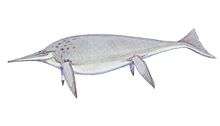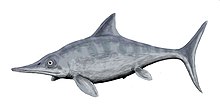Suevoleviathan
Suevoleviathan is an extinct genus of primitive ichthyosaur found in the Early Jurassic (Toarcian) of Holzmaden, Germany.
| Suevoleviathan | |
|---|---|
| Fossil of S. integer | |
| Scientific classification | |
| Kingdom: | |
| Phylum: | |
| Class: | |
| Order: | |
| (unranked): | |
| Family: | †Suevoleviathanidae Maisch, 2001 |
| Genus: | †Suevoleviathan Maisch, 1998 |
| Species | |
| |
Taxonomy

The genus was named in 1998 by Michael Maisch for Leptopterygius disinteger and Ichthyosaurus integer, both found in the Toarcian-age Posidonia Shale of Holzmaden.[2] The generic name means "Swabian Leviathan". The type species is Leptopterygius disinteger Huene 1926. Ichthyosaurus integer Bronn 1844 was also reassigned to the genus by Maisch to create the new combination Suevoleviathan integer.
Based on the relocation of the holotype of Suevoleviathan integer and an updated description of the specimen, Maxwell (2018) concluded that the two Suevoleviathan species are growth stages of the same species, meaning that S. integer has priority and becomes the epithet of the Suevoleviathan type species.[3]
Description
Suevoleviathan was a large ichthyosaur about four meters long. The skull is low, orbit medium-sized, dorsal profile of skull only weakly concave; premaxilla and dentary with well developed grooves extending in an alternating fashion from the fossa praemaxillaris and fossa dentalis; maxilla short anteriorly, not reaching far beyond external naris, taking part in the formation of external naris and ventral orbital margin, separating lacrimal and jugal; jugal robust and short, not extending beyond anterior orbital margin; squamosal large, forming most of the posterior margin of cheek region and reaching down to ventral margin of cheek, processus quadratus of quadratojugal thus apparently separated from main body of bone; prefrontal and postfrontal subequal in size; external naris large, of triangular shape; posterior maxillary dentition reduced; teeth robust and crenulated in typical fashion, without carinae; 44 presacral vertebrae, 88 preflexural vertebrae; postflexural segment of tail very long and flexible; neural arches of posterior thoracal region very low with expanded processus spinosi; rib articulations of thorax unicipital posteriorly; forefin with three primary digits, fourth digit postaxial, one accessory digit; third digit subdivided into 3 secondary rays; no notches in leading edge of forefin; digits of the forefin fanning out distally; most autopodial elements rounded and widely spaced; pelvis tripartite; illium with anterior spine-like process; pubis slender and curved; ischium broad and subrectangular; hindfin tridactyl, most elements of first digit notched.[2]
See also
- List of ichthyosaurs
- Timeline of ichthyosaur research
References
- "†Suevoleviathan Maisch 1998 (ichthyosaur)". Paleobiology Database. Fossilworks. Retrieved 11 August 2017.
- Maisch, W.A., 1998, A new ichthyosaur genus from the Posidonia Shale (Lower Toarcian, Jurassic) of Holzmaden, SW-Germany with comments on the phylogeny of post-Triassic ichthyosaurs. Neues Jahrbuch für Geologie und Paläontologie, Abhandlungen, 209: 47–78
- Maxwell, E. E. 2018. Redescription of the ‘lost’ holotype of Suevoleviathan integer (Bronn, 1844) (Reptilia: Ichthyosauria). Journal of Vertebrate Paleontology. DOI: 10.1080/02724634.2018.1439833.

